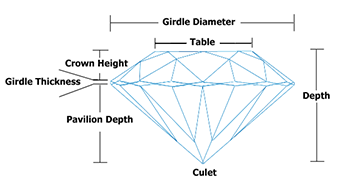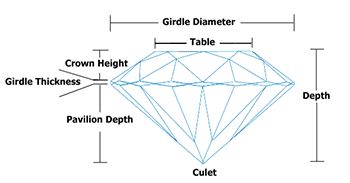Rubies come in a wide range of natural colors and shades of red. The color range includes pinkish, purplish, orangey and brownish red depending on the chromium and iron content of the stone. The most valuable rubies have a vivid, medium-dark red to slightly purplish red color. Many fine rubies from Myanmar have a slight purple secondary color. Color is mainly caused by the gemstones’ selective absorption of certain wavelengths of light called the body color. In gemstones, color consists of three components:
Hue - the first impression of the color
Tone - the lightness or darkness of color ranging from light to medium to dark
Saturation - the intensity of a gemstone's color which is measured from dull to strong to vivid
Gemologists use the term "inclusion" to define characteristics found inside a stone. Inclusions are often used as an indication that the gemstone is of natural origin. A "blemish" is a characteristic that affects the stone's surface.
Ruby Inclusions
Crystals - solid inclusions of various shapes and sizes. Extremely small crystals are referred to as pinpoints or grains.
Silk - fine fibers of titanium dioxide (rutile) or other minerals that resemble the look of silk. Well-formed silk indicates that the ruby underwent no heat-treatment and is of natural origin. Silk is a preferred inclusions in rubies.
Needles - long, thin inclusions of either crystals, or tubes filled with gas or liquid (growth tubes)
Cracks - feather-like inclusions also known as fractures or fissures
Parting - breakage along a plane of weakness
Twinning - two crystals grown out of one another or next to each other
Halos - circular fractures surrounding a crystal
Fingerprints - common in ruby, these inclusions look like human fingerprints
Color zoning - uneven color distribution in the ruby
Cavities - holes extending into the ruby from the surface
Chips - broken off pieces along the girdle or on the culet of the ruby
Ruby Surface Blemishes
Scratches - lines scraped on a gemstone
Pits - tiny holes on the stone's surface
Nicks - broken parts of a stone's girdle or facet
Abrasions - rough scrapings along the stone's facet edges
Clarity Grades
Asian Gem Centre assigns the following clarity grades to its rubies:
A+: Perfection: The stone is clean to the eye, but not necessarily at 10x magnification.
A: Insignificant Inclusions: The stone has very small visible inclusions
B+: Very Slightly Included: Inclusions or small internal crystals are only slightly visible on close inspection
B: Slightly Included: Inclusions or small internal crystals are visible on close inspection.
C: Included: Inclusions are visible
Transparency
The degree of visibility through a ruby is known as its transparency. It is an often-overlooked characteristic when discussing rubies. Transparency is designated as follows:
Transparent - objects look clear and distinct through the stone. These rubies usually have excellent brilliance despite any inclusions they may have.
Semitransparent - objects look slightly hazy or blurry through the stone
Translucent - objects are difficult to see through the ruby. Light can pass through, but it is somewhat diffused.
Semi-translucent or semi-opaque - a small fraction of light passes through the stone
Opaque - almost no light passes through the stone
The best ruby cuts offer a depth/width ratio higher than comparable diamond cuts. Expect a depth percentage of 65% to 80% for good quality rubies (the depth percentage is depth/width). Stones that are too deep will look smaller than expected but they will show off more color than they would if they were cut to normal proportions. Deep-cut stones also preserve weight, increasing the cost of the stone without the expected increase in the size of the crown (top portion of the gem). Stones that are too shallow will look big for their weight and appear lighter in color than deeper-cut stones. Good quality rubies also have good symmetry when viewed in profile - reflecting the light evenly.

The overall grade is determined by looking at Hue, Tone, Color-Purity, Clarity, Transparency and Cut.
Weight is an important quality of ruby value. Often the larger the stone, the more valuable it is, as larger stones more rare. However, it is important to remember that qualities such as color and saturation are also very important in determining a stone's value.
The English word carat come from the Greek keration ('little horn'), referring to the shape of the seedpods of the carob tree. These seeds are small and uniform in weight; therefore, they were a standard for weighing gemstones in early times.
Around 1920, the metric carat was adopted as an international standard. One carat equals a fifth of a gram (0.20 gram), or five carats to the gram.
Tavernier's Law
Generally, as a gemstone's carat weight increases, so does the price per carat. A fun way to look at stone values is the following: since the late 14th century there has been a law for diamonds that is known as the 'Indian Law' or 'Tavernier's Law':
Wt² x C = Price per Stone
The following shows how the price of a gemstone might increase with this formula applied to a $1000 a carat base price.
However, in the real world, pricing is not this simple. Other qualities such as color or clarity affect the price of the stone. With colored gemstones, this carat law is even more muddled and unrealistic. A high quality ruby of three carats may be more valuable and rarer than a ruby of over 200 carats, as huge rubies are common, but full of serious inclusions. These giant specimens are impossible to cut into fine stones because of their flaws; therefore, their value is very low.
Also, remember that size and weight are different. Size refers to the physical space or volume that a stone occupies, while weight refers to the gravitational pull of the object. For example, one cubic millimeter of ruby will be twice as heavy as one cubic millimeter of opal because the ruby’s specific gravity is twice that of opal.
Approximate Carat Weights for Calibrated Rubies
Calibrated Size Chart for Ovals:
Calibrated Size Chart for Emerald Cut:
Calibrated Size Chart for Rounds:
Calibrated Size Chart for Marquise:
Calibrated Size Chart for Squares:
Calibrated Size Chart for Pears:
Sapphires come in a wide range of natural colors and shades. Sapphires are available in every color but red. Sapphires in colors other than blue are often referred to as fancy sapphires. The most valuable sapphires have a medium intense, vivid blue color. Black, gray, or green overtones mixed in with the blue will reduce a stone's value. A more pastel blue would be less preferred than a vivid blue but would still be priced higher than an over dark blackish blue color. Color is mainly caused by the gemstone's selective absorption of certain wavelengths of light called the body color. In gemstones, color consists of three components:
Hue - the first impression of the color
Tone - the lightness or darkness of color ranging from light to medium to dark
Saturation - the intensity of a gemstone's color which is measured from dull to strong to vivid
Yellow sapphires are mined in Australia. Green sapphires come from Queensland. From Sri Lanka's gem-bearing gravels can be found sapphires in hues of royal blue, cornflower blue, pink, yellow, orange (a rare color), violet and gemstones with two or more colors. Yet gem dealers’ prize sapphires of a cornflower blue variety above all. Such stones, with a velvet depth to them, mined in Kashmir, are the most sought after due to their rarity. From Montana are mined a dark blue sapphire with a distinctive metallic sheen. Truly colorless sapphires are rare but are found in Sri Lanka, as are cloudy, milk-colored ones, which are called "geuda." Heat treatment is used to change the geuda into a blue stone.
Blue sapphires tend to have more inclusions than most fancy-color sapphires. Gemologists use the term "inclusion" to define characteristics found inside a stone. Inclusions are often used as an indication that the gemstone is of natural origin. A "blemish" is a characteristic that affects the stone's surface.
Sapphire Inclusions
Crystals - solid inclusions of various shapes and sizes. Extremely small crystals are referred to as pinpoints or grains.
Silk - fine fibers of titanium dioxide (rutile) or other minerals that resemble the look of silk. Well-formed silk indicates that the sapphire underwent no heat-treatment and is of natural origin. Silk is a preferred inclusion in sapphires.
Needles - long, thin inclusions of either crystals, or tubes filled with gas or liquid (growth tubes)
Cracks - feather-like inclusions also known as fractures or fissures
Parting - breakage along a plane of weakness
Twinning - two crystals grown out of one another or next to each other
Halos - circular fractures surrounding a crystal
Fingerprints - common in sapphire, these inclusions look like human fingerprint outlines
Color zoning - uneven color distribution in the sapphire
Cavities - holes extending into the sapphire from the surface
Chips - broken off pieces along the girdle or on the culet of the sapphire
Sapphire Surface Blemishes
Scratches - lines scraped on a gemstone
Pits - tiny holes on the stone's surface
Nicks - broken parts of a stone's girdle or facet
Abrasions - rough scrapings along the stone's facet edges
Clarity Grades
Asian Gem Centre assigns the following clarity grades to its sapphires:
Clarity Grades
Asian Gem Centre assigns the following clarity grades to its rubies:
A+: Perfection: The stone is clean to the eye, but not necessarily at 10x magnification.
A: Insignificant Inclusions: The stone has very small visible inclusions
B+: Very Slightly Included: Inclusions or small internal crystals are only slightly visible on close inspection
B: Slightly Included: Inclusions or small internal crystals are visible on close inspection.
Transparency
The degree of visibility through a sapphire is known as its transparency. It is an often-overlooked characteristic when discussing sapphires. Transparency is designated as follows:
Transparent - objects look clear and distinct through the stone. These sapphires usually have excellent brilliance despite any inclusions they may have.
Semitransparent - objects look slightly hazy or blurry through the stone
Translucent - objects are difficult to see through the sapphire. Light can pass through, but it is somewhat diffused.
Semi-translucent or semi-opaque - a small fraction of light passes through the stone
Opaque - no light passes through the stone
The best sapphire cuts offer a depth/width ratio higher than comparable diamond cuts. Expect a depth percentage of 65% to 80% for good quality sapphires (the depth percentage is depth/width). Stones that are too deep will look smaller than expected but they will show off more color than they would if they were cut to normal proportions. Deep-cut stones also preserve weight, increasing the cost of the stone without the expected increase in the size of the crown (top portion of the gem). Stones that are too shallow will look big for their weight and appear lighter in color than deeper-cut stones.
Good quality sapphires also have good symmetry when viewed in profile - reflecting the light evenly.

The overall grade is determined by looking at Hue, Tone, Color-Purity, Clarity, Transparency and Cut.
Weight is an important quality of sapphire value. Often the larger the stone, the more valuable it is, as larger stones more rare. However, it is important to remember that qualities such as color and saturation are also very important in determining a stone's value.
The English word carat come from the Greek keration ('little horn'), referring to the shape of the seedpods of the carob tree. These seeds are small and uniform in weight; therefore, they were a standard for weighing gemstones in early times.
Around 1920, the metric carat was adopted as an international standard. One carat equals a fifth of a gram (0.20 gram), or five carats to the gram.
Tavernier's Law
Generally, as a gemstone's carat weight increases, so does the price per carat. A fun way to look at stone values is the following: since the late 14th century there has been a law for diamonds that is known as the 'Indian Law' or 'Tavernier's Law':
Wt² x C = Price per Stone?
The following shows how the price of a gemstone might increase with this formula applied to a $1000 a carat base price.
However, in the real world, pricing is not this simple. Other qualities such as color or clarity affect the price of the stone. With colored gemstones, this carat law is even more muddled and unrealistic. A high quality sapphire of three carats may be more valuable and rarer than a sapphire of over 200 carats, as huge sapphires are common, but full of serious inclusions. These giant specimens are impossible to cut into fine stones because of their flaws; therefore, their value is very low.
Also, remember that size and weight are different. Size refers to the physical space or volume that a stone occupies, while weight refers to the gravitational pull of the object. For example, one cubic millimeter of sapphire will be twice as heavy as one cubic millimeter of opal because the sapphire’s specific gravity is twice that of opal.
Approximate Carat Weights for Calibrated Sapphires
Calibrated Size Chart for Ovals:
Calibrated Size Chart for Emerald Cut:
Calibrated Size Chart for Rounds:
Calibrated Size Chart for Marquise:
Calibrated Size Chart for Squares:
Calibrated Size Chart for Pears:
